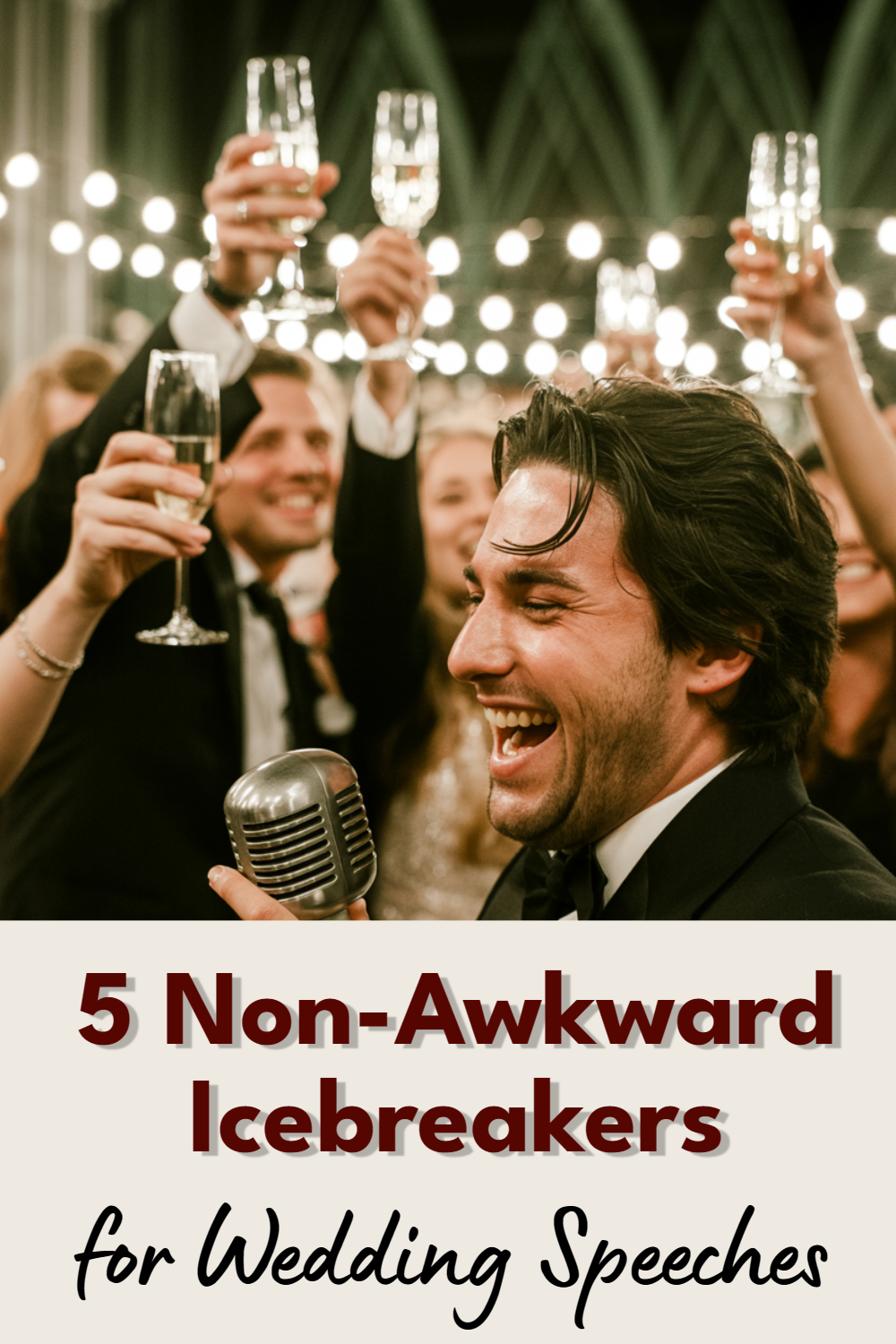Standing in front of a room full of wedding guests, microphone in hand, watching dozens of expectant faces stare back at you—it’s enough to make anyone’s palms sweat.
The opening line of your speech can make or break the entire moment, setting the tone for everything that follows.
1. The Shared Memory Hook
Starting with a specific, relatable memory instantly connects you with both the couple and the audience. This technique works because it grounds everyone in a real moment rather than abstract pleasantries or generic observations about love.
Choose a memory that involves multiple people in the room, not just you and the bride or groom. Maybe it’s the night everyone stayed up until 3 AM helping them move apartments, or the disastrous camping trip where Sarah insisted she could read a map.
The key is picking something that makes people smile and nod in recognition.
“I’ll never forget the night Tom called me at midnight, completely panicked because he’d accidentally double-booked his first date with Emma and his weekly poker game with us. Little did we know Emma would end up joining poker night—and taking all our money.“
The beauty of this opener lies in its authenticity. You’re not trying to be clever or profound; you’re simply sharing a genuine moment that reveals character. It immediately establishes your relationship with the couple while giving the audience something concrete to latch onto.
Avoid memories that require extensive backstory or inside jokes that exclude most guests. The goal is inclusion, not showcasing how close you are to the couple.
Test your memory on someone who wasn’t there—if they need three clarifying questions to understand it, choose something else.
2. The Gentle Roast
A well-executed gentle roast can be comedy gold, but it requires finesse and deep knowledge of your audience. The secret is targeting quirks and habits that are endearing rather than embarrassing, focusing on traits that actually make the person more lovable.
Think about the groom’s obsession with organizing his sock drawer by color, or the bride’s tendency to research restaurants for three hours before choosing where to eat.
These are the kinds of “flaws” that make people human and relatable, not the ones that make them cringe.
“For those who don’t know Rachel well, she’s the type of person who reads Yelp reviews for ice cream shops. Not just reads them—prints them out and organizes them by flavor preference.
When she told me she was ready to settle down, I knew Mark must be pretty special because she definitely did her research.“
The roast should feel like it comes from a place of genuine affection. Your tone and delivery matter enormously here—you want knowing chuckles, not uncomfortable silence.
Practice this opener with someone who knows the couple to gauge whether you’ve hit the right note.
Never roast anything the person can’t control, past relationships, family drama, or genuinely sensitive topics. The goal is to highlight their quirks in a way that makes everyone think, “Oh, that’s so them!” rather than “Yikes, I can’t believe they said that.”
3. The Unexpected Compliment
Sometimes the most powerful icebreaker is highlighting a quality about the couple that guests might not immediately recognize. This technique works particularly well when you can illuminate something meaningful beneath the surface of everyday interactions.
Look for moments when the bride or groom showed unexpected depth, kindness, or strength. Maybe the groom who seems laid-back actually spent months secretly planning surprise birthday parties for his friends.
Perhaps the bride who appears to have everything together once drove four hours to comfort you during a breakup.
“Most of you know Jenny as the woman who somehow manages to look put-together even at 6 AM spin class.
But what you might not know is that she’s also the person who noticed when our elderly neighbor Mrs. Chen stopped picking up her mail, and spent three weeks quietly checking on her until she felt comfortable asking for help.“
This opener works because it reveals character while positioning you as someone who truly sees and appreciates the person you’re honoring. It creates a moment of genuine warmth that sets a beautiful tone for the rest of your speech.
Choose compliments that feel specific and earned rather than generic praise. Anyone can say someone is “kind” or “funny,” but pointing to concrete examples of those qualities in action creates much more impact.
The audience should finish your opening thinking they understand the person a little better.
4. The Evolution Story
Tracing how someone has changed or grown over the years creates natural narrative momentum while celebrating personal development. This opener works especially well if you’ve known the couple for a long time and can speak to their journey.
Focus on positive evolution—how they’ve become more confident, more adventurous, or more themselves.
Maybe the shy college roommate who used to order pizza by writing out a script first is now confidently giving presentations to executives. Perhaps the commitment-phobic friend finally found someone worth staying still for.
“I’ve known Mike for fifteen years, and I’ve watched him go from the guy who kept three different dating apps on his phone ‘just in case’ to the man who deleted them all after one coffee date with Lisa. Some people might call that character growth. I call it finally meeting his match.“
The evolution story works because it acknowledges that people aren’t static—they grow, change, and become better versions of themselves, often inspired by the right relationships. It’s inherently hopeful and forward-looking, which fits perfectly with the wedding context.
Avoid highlighting negative past behaviors or making anyone sound like they were a mess before meeting their partner.
The evolution should feel like natural growth rather than dramatic rescue or complete personality overhaul. Everyone should feel good about the journey you’re describing.
5. The Behind-the-Scenes Moment
Sharing a private moment that reveals the couple’s authentic dynamic can be incredibly powerful, especially if it shows them in a slightly different light than their public personas might suggest.
This opener works because it makes the audience feel like they’re getting insider access to the real relationship.
Look for moments when they thought no one was watching—how they interact in the kitchen while cooking together, their ritual of texting each other funny memes throughout the workday, or the way they automatically split dessert without discussing it.
These small intimacies often reveal more about compatibility than grand gestures.
“Last month, I stopped by their apartment unannounced and found them having a heated debate about whether cereal counts as soup. David was citing dictionary definitions while Maria was drawing diagrams on napkins.
They argued for twenty minutes, and then David said, ‘You know what? You’re absolutely right about the milk temperature thing.’ That’s when I knew these two were going to make it.“
This type of opener humanizes the couple while highlighting their unique dynamic. It shows them as real people with silly conversations and genuine connection, not just the polished version everyone sees at parties.
Choose moments that feel warm and inclusive rather than overly private or intimate. The goal is to give guests insight into the relationship’s foundation, not to make anyone uncomfortable with too much personal information.
The Art of Reading the Room
Understanding your audience is crucial for any icebreaker’s success. Wedding guests represent a unique mix of generations, relationships, and comfort levels with humor.
Your opener needs to work for Great Aunt Martha and your college fraternity brothers simultaneously.
Conservative family members might appreciate the shared memory or unexpected compliment approaches, while friend groups might respond better to gentle roasting or behind-the-scenes moments.
When in doubt, err on the side of warmth over wit—genuine affection translates across all demographics.
Pay attention to the wedding’s overall tone and setting. A backyard barbecue reception calls for different energy than a formal ballroom celebration. Your icebreaker should feel like it belongs in the same universe as the rest of the event.
Practice your opener with people who represent different parts of your audience. If your college roommate loves it but your mother looks concerned, you might need to adjust your approach. The best icebreakers feel effortless and appropriate to everyone listening.
Delivery Tips That Actually Matter
Even the perfect icebreaker can fall flat with poor delivery. Confidence matters more than perfection—guests want to see you succeed, and they’ll forgive minor stumbles if you seem genuinely happy to be there.
Speak slowly and clearly, especially during your opening lines. Nervous speakers tend to rush, but your icebreaker needs time to land. Pause after your opening sentence to let people process what you’ve said before moving forward.
Make eye contact with different sections of the room, not just the couple. Your icebreaker should feel like you’re talking to everyone, not performing for an audience of two. This helps create the inclusive atmosphere that makes or breaks wedding speeches.
Record yourself practicing your opener on your phone. You’ll quickly identify if you’re speaking too fast, using too many filler words, or not projecting enough. Most people are surprised by how different they sound when recorded versus how they think they sound.
Common Pitfalls to Sidestep
The biggest mistake speakers make is trying too hard to be funny rather than being authentic. Comedy is subjective, but genuine warmth is universal. If you’re not naturally funny, don’t force it—sincerity will serve you better than failed attempts at humor.
Avoid opening with apologies about your nerves or speaking abilities. Statements like “I’m not good at this” or “I’m so nervous” make the audience uncomfortable and undermine your credibility before you’ve even started. Just begin with your chosen icebreaker.
Don’t use someone else’s opening line, no matter how perfect it seems. Wedding guests can sense authenticity, and borrowed material rarely fits your specific relationship with the couple. Your personal connection is your greatest asset—use it.
Skip the generic observations about marriage, love, or how beautiful the bride looks. Everyone expects these comments, so they don’t function as effective icebreakers. Save the broader reflections for later in your speech after you’ve established your unique voice.
Making Your Choice
The best icebreaker for your speech depends on your personality, your relationship with the couple, and the specific stories you have to tell.
Don’t choose the gentle roast if you’re not comfortable with humor, and don’t force a behind-the-scenes moment if you don’t have access to those intimate details.
Consider what you genuinely want the audience to understand about the couple. Your icebreaker should serve that larger purpose, not just get a laugh or break the tension.
The opening line is your chance to establish the lens through which everyone will view the rest of your speech.
Trust your instincts about what feels right for this specific couple and this specific celebration. The perfect icebreaker for your best friend’s casual outdoor wedding might be completely wrong for your sister’s formal church ceremony. Context matters enormously.
Finding Your Voice in the Moment
Once you’ve chosen your icebreaker and practiced your delivery, the final step is trusting yourself to adapt in the moment.
Weddings are unpredictable, and rigid adherence to your planned opening might not serve you if the energy in the room is different than expected.
Pay attention to how previous speakers have been received. If the crowd seems eager for lightness, lean into humor. If the mood is more sentimental, emphasize the emotional aspects of your chosen opener. Flexibility will serve you better than perfectionism.
Your icebreaker is just the beginning of your speech, not the entire performance. Even if it doesn’t land exactly as planned, you have several more minutes to connect with the audience and honor the couple.
Give yourself permission to be imperfect and human—that’s often when the most memorable moments happen.


